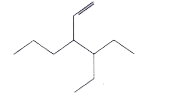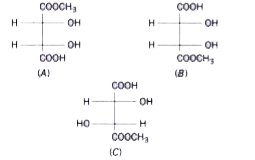Complete Solutions to OBJECTIVE ( MULTIPLE CHOICE ) TYPE QUESTIONS of chapter ORGANIC CHEMISTRY : SOME BASIC PRINCIPLES AND TECHNIQUES of Class 11 book with complete answers and questions
| Class 11 | CHEMISTRY |
| Chapter | ORGANIC CHEMISTRY : SOME BASIC PRINCIPLES AND TECHNIQUES |
| NOOTAN | OBJECTIVE ( MULTIPLE CHOICE ) TYPE QUESTIONS |
| Number Of Questions | 100 |
| Academic Year | 2023-24 |
What is the correct IUPAC name of the following compound?
` CH_3 CH_2CH_2 CH_2 CH_2 underset(CH_3 ) underset(| )(CH )- underset(CH_2 CH_2 CH_3) underset(|)overset(CH_3) overset(|) C- CH_2 CH_3`
3, 4-dimethyl-3n-propylnonane
6,7-dimethyl-2-n-propyinonane
6,7-dimethyl-7-ethyldecane
4,5-dimethyl-4-ethyldecane.
View SolutionName of the compound
` H_3 C - underset(CH_3)underset(|) overset(CH_3) overset(|) C- CH =CH_2`
as per IUPAC system is
View SolutionThe compound which has one isopropyl group is
2, 2, 3, 3-tetramethylpentane
2,2-dimethylpentane
2, 2, 3-trimethylpentane
2-methylpentane.
View SolutionThe IUPAC name of the compound having structure
`C_2 H_5 - underset (CH_2 )overset(||) C-`
View SolutionWhich of the following IUPAC names is not correctly matched?
View SolutionHow many isomers are possible for the alkyl group `-C_4 H_9`
View SolutionThe IUPAC name of the compound
`underset(CN) underset(|) (CH_2) - underset(CN) underset(|)(CH ) - underset(CN)underset(|)(CH_2) ` is
View SolutionWrite the IUPAC names of the compound:
`CH_2 = CH - CH -= C - CH_3`
View SolutionThe IUPAC name of `CH_3-underset(OH) underset(। )CH-CH_2-underset(CH_3) underset(। )(CH)-CHO `will be
View Solution2-methylbut-2-ene will be represented as
View SolutionIn which of the following compounds is the numbering of carbon atoms in the chain correct?
View SolutionIUPAC name of `CH_3 CH(OH)CH_2 CH_2 COOH` is
View SolutionThe IUPAC name of the following compounds is
`CH_2 = underset(CH_3) underset(|) underset(" "CH-CH_3) underset(|)(C )-CH_2 -CH_3`
View SolutionThe IUPAC name of the compound

View SolutionWhich of the following compounds is 2,2,3-trimethylhexane?
View SolutionThe correct name of the following compound is
`{:(CH_3 CH_2-C= CH- overset(CH_3 ) overset(|)CH-CH_2-CH_3),(" "|),(CH_3CH_2-CH-CH_2 -CH_2 -CH_2-CH_3):}`
View SolutionThe IUPAC name of

View SolutionThe IUPAC name of `CH_3-C-= C.CH(CH_3)_2` is
View SolutionFollowing types of compounds (as I, II)
`(I) CH_3 CH = CHCH_3`
`(II) CH_3 - underset(CH_2 CH_3)underset(|) CH -OH `
are studied in terms of isomerism in
View SolutionThe IUPAC name of `CH_3 COCH(CH_3)_2` is
View SolutionThe IUPAC name of the compound

View SolutionOf the five isomeric hexanes, the isomer which can give two monochlorinated compounds is
2-methylpentane
2,2-dimethylbutane
2,3-dimethylbutane
n-hexane.
View SolutionThe IUPAC name of the compound shown below is

View SolutionThe IUPAC name of
 is
is
View SolutionThe correct IUPAC name of the compound
 is
is
View SolutionWhich nomenclature is not according to IUPAC system?
View SolutionThe compounds butan-1-ol and 2-methylpropan-1-ol are
View SolutionWhich of the following statements is correct?
View SolutionWrite the structures of three ethers with molecular formula `C_(4)H_(10)O`.
View SolutionPropanal is the functional isomer of
View SolutionIn tautomerism, the two tautomeric forms continuously change into each other through the oscillation of
View SolutionThe enolic form of `CH_3 -overset(O ) overset(।। )C- CH_2 COOC_2 H_5` is
View SolutionHow many chain isomers are possible with the formula `C_7 H_(16) ?`
View SolutionThe isomerism shown by butan-1-amine and 2-methylpropan l-amine is
View SolutionThe number of conformations exhibited by ethane is
View SolutionWhich of the following statements is correct?
View SolutionAt room temperature, the staggered and eclipsed conformers of ethane continuously change into each other. This is because
View SolutionWhich of the following letters possesses chirality ?
A
X
H
J
View SolutionA compound of the type `C_(abd) - C_(abd)`
View SolutionThe compound represented by the following structure
`{:(" "COOH),(" "|),(H-C-OH),(" "|),(H-C-OH),(" "|),(" "COOH):}`
is optically inactive because
View SolutionWhich of the following compounds does possess one or more asymmetric carbon atoms?
View SolutionThe d- and l- forms of an optically active compound are called
View SolutionLactic acid (2-hydroxypropanoic acid) is an optically active compound. It can be made optically inactive by
View SolutionWhen pyruvic acid `(CH_3 -overset(O )overset(|| ) C-COOH) `is reduced under normal conditions
View SolutionWhich of the following types of compounds is unable to exhibit geometrical isomerism ?
View SolutionWrite the systematic IUPAC names of the following compounds :
`C_6 H_5 - CH=CH-COOH`
View SolutionWhich of the following compounds cannot exist in cis and trans forms?
View SolutionWhich of the following statements is not correct?
View SolutionConsider the following conformations. Which of the following statements is correct?

View SolutionThe structure
 shows
shows
View SolutionWhich of the following has an asymmetric carbon atom ?
(a)`CH_3 - CH_2 -CH_2Br`
(b)`CH_3 - underset(Br) underset(|) overset(H) overset(|)C- underset(CH_3) underset(|) CH - CH_3`
(c)`CH_3 - cH_2 -underset(CH_3)underset(|) overset(Br) overset(|)C-CH_3`
(d)`CH_3 - underset(Br) underset(|) overset(|) overset(CH_3) overset(|) C- CH_2 -CH_2-CH_3`
View SolutionThe compound which does not exhibit optical isomerism is
View SolutionThe correct statements about the compounds A, B and C is

View SolutionHow many optically active stereoisomers are possible for butane-2, 3-diol
1
2
3
4
View SolutionDuring debromination of meso-dibromobutane, the major compound formed is
n-butane
but-1-ene
cis-but-2-ene
trans-but-2-ene
View SolutionWhich one of the following compounds will show geometrical isomerism ?
View SolutionOut of the following, the alkene that exhibits optical isomerism is
3-methyl-2-pentene
4-methyl-1-pentene
3-methyl-1-pentene
2-methyl-2-pentene
View SolutionIdentify the compound that exhibits tautomerism:
2-butene
lactic acid
2-pentanone
phenol
View SolutionHow many chiral compounds are possible on monochlorination of 2-methyl butane?
View SolutionWhich branched chain isomer of the hydrocarbon with molecular mass `72u` gives only one isomer of mono substituted alkyl halide ?
View SolutionWhich of the following acids does not exhibit optical isomerism?
View SolutionLassaigne's test is used in the qualitative analysis to detect
View SolutionA compound which does not give positive test for nitrogen is:
urea
azobenzene
glycine
phenyl hydrazine.
View SolutionFor detection of sulphur in an organic compound, sodium nitroprusside is added to the sodium extract. A violet colour is obtained which is due to the formation of
View SolutionIn sodium fusion test of organic compounds, the nitrogen of an organic compound is converted to
View SolutionThe Beilstein test for organic compounds is used to detect
View SolutionIn the Duma's method for estimating nitrogen in an organic compound, the gas finally collected is
View SolutionIn Kjeldahl's method, nitrogen present is estimated as
View SolutionCarbon and hydrogen are estimated by
View SolutionA compound containing 80% C and 20% H is likely to be:
`C_6 H_6`
`C_2 H_6`
`C_2 H_4`
`C_2 H_2`
View SolutionAn organic compound is found to contain C - 40%. 0 = 53.34% and H = 6.66%. Its empirical formula is
View SolutionAn organic compound has an empirical formula `CH_2 O`. Its vapour density is 45. The molecular formula of the compound is
View SolutionThe empirical formula of a compound is `CH_2`. One mole of this compound has a mass of 42 grams. Its molecular formula is
View SolutionThe concentration of C = 85.45%, and H = 14.44% is not obeyed by the formula
View SolutionIf two compounds have the same empirical formula but different molecular formula, they must have
View Solution0.759 g of a silver salt of a dibasic organic acid on ignition gave 0.463 g of silver. The molecular mass of the acid is
View Solution0.400 g of chloroplatinate salt of a monoacid base on ignition gave 0.125 g of platinum. Find the molecular mass of the base.
View Solution0.500 g of the silver salt of an organic dibasic acid on ignition gives 0.325 g of pure silver. Find the molecular mass of the acid.
View SolutionIn a Victor Meyer's determination of molecular mass, 0.1015 g of an organic substance displaced 26.16 mL of air at S.T.P. The molecular mass of the substance is
View Solution0.29 g of an organic compound on combustion gave 0.66 g of `CO_2` and 0.27 g of `H_2 O`. The percentage of carbon and hydrogen in the given compound respectively are
View SolutionThe blue compound formed in the positive test for nitrogen with Lassaigne solution of an organic compound is
View SolutionThe ammonia evolved from the treatment of 0.30 g of an organic compound for the estimation of nitrogen was passed in 100 mL of 0.1 M sulphuric acid. The excess of acid required 20 mL of 0.5 M sodium hydroxide solution for complete neutralisation. The organic compound is:
acetamide
benzamide
urea
thiourea
View SolutionAn organic compound having molecular mass 60 is found to contain C = 20%, H = 6.67% and N = 46.67% while rest is oxygen. On heating it gives NH3 along with a solid residue. The solid residue gives violet colour with alkaline copper sulphate solution. The compound is?
View SolutionThe blue compound formed in the positive test for nitrogen with Lassaigne solution of an organic compound is
View Solution29.5 mg of an organic compound containing nitrogen was digested according to Kjeldahl's method and the evolved ammonia was absorbed in 20 mL of 0.1 M HCl solution. The excess of the acid required 15 mL of 0.1 M NaOH solution for complete neutralization. The percentage of nitrogen in the compounds is
View SolutionIn Dumas’ method for estimation of nitrogen, 0.3g of an organic compound gave 50mL of nitrogen collected at 300K temperature and 715mm pressure. Calculate the percentage composition of nitrogen in the compound. (Aqueous tension at 300K=15 mm)
View SolutionFor testing halogens in an organic compound with `AgNO_(3)` solution, sodium extract (Lassaigne's test) is acidified with dilute `HNO_(3)`. What will happen if a student acidifies the extract with dilute `H_(2)SO_(4)` in place of dilute `HNO_(3)` ?
View SolutionIn the Kjeldahl's method for estimation of nitrogen present in a soil sample, ammonia evolved from 0.75 g of sample neutralised 10 mL of 1 M H2SO4. The percentage of nitrogen in the soil is
View SolutionFor the estimation of nitrogen `1.4 g` of organic compound was diagest by Kjedahl method an the evolved ammonia was absorbed in `60 mL` of `M/10` sulphuric acid. The unreacted acid required 20 ml of `M/10` sodium hydroxide for complete neutralization. The percentage of nitrogen in the compound is :
View SolutionWhich of the following ions is most stable ?
View SolutionThe number of electrons present in the valence shell of carbon bearing negative charge in a carbanion is
View SolutionThe compound which gives the most stable carbonium ion on dehydration is
View SolutionIn a free radical, the carbon atom carrying unpaired electron is
View SolutionNitration of benzene is
View SolutionThe reaction intermediates involved in the addition of HBr to propene in the presence of an organic peroxide are
(a) free radicals
(b)carbocations
(c)carbanions
(d)carbenes
View SolutionThe shape of carbanion `[CH_(3)]^(-) ` is:
linear
bent
pyramidal
tetrahedral
View SolutionWhich of the following is an electrophile ?
`NH_3`
`AlCl_3`
`OH^(-)`
`CH_3-O-CH_3`
View SolutionHeterolytic fission of C—Cl bond produces
two free radicals
two carbonium ions
two carbanions
one cation and one anion.
View SolutionWhich one of the following is the strongest acid ?
View SolutionThe most stable free radical is
View Solution
OBJECTIVE ( MULTIPLE CHOICE ) TYPE QUESTIONS questions and complete solutions for chapter ORGANIC CHEMISTRY : SOME BASIC PRINCIPLES AND TECHNIQUES of NAGEEN CHEMISTRY (ENGLISH) of Class 11
All Exercises from NOOTAN Class 11 CHEMISTRY ORGANIC CHEMISTRY : SOME BASIC PRINCIPLES AND TECHNIQUES
- ASSERTION - REASON TYPE QUESTIONS
- ESSAY ( LONG ANSWER ) TYPE QUESTIONS
- EXAMPLES
- FILL IN THE BLANK TYPE QUESTIONS
- NCERT TEXT-BOOK EXERCISES (WITH HINTS AND SOLUTIONS )
- OBJECTIVE ( MULTIPLE CHOICE ) TYPE QUESTIONS
- REVIEW EXERCISES
- SHORT ANSWER TYPE QUESTIONS
- TRUE OR FALSE TYPE QUESTIONS
- VERY SHORT ANSWER TYPE QUESTIONS